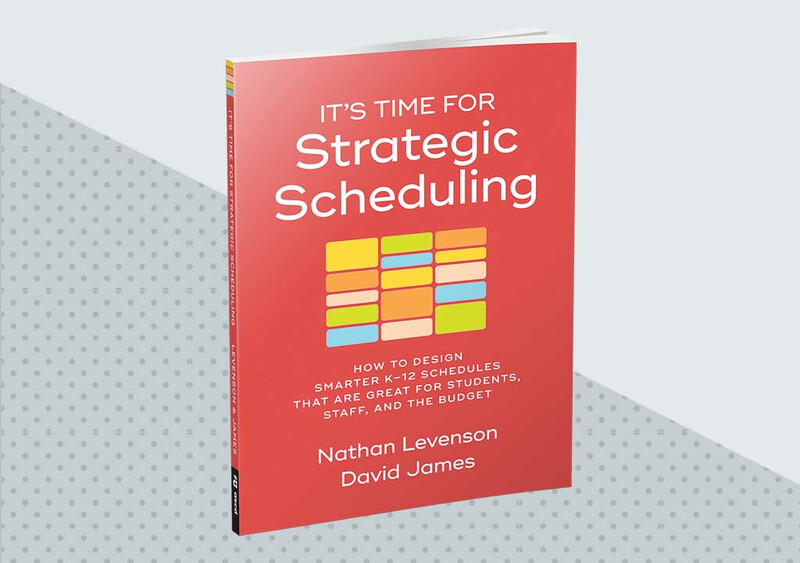Creating elementary school schedules can be a complicated, sometimes messy task. This is especially the case when you start to factor in all of the “other” schedules in a school beyond classroom schedules, like those of interventionists, special educators, and specialists. Designing a best-in-class schedule requires thoughtful coordination across many groups of teachers and staff.
In our book, It’s Time for Strategic Scheduling: How to Design Smarter K–12 Schedules That Are Great for Students, Staff, and the Budget (ASCD), my co-author Nate Levenson and I outline what research and practical experience highlight as best practices to create truly strategic school schedules. As you start to ramp up your own process to create school schedules for next year, be sure to keep the following in mind.
Schedule as a School, Not by Classroom
I recently advised a district on their approach to elementary scheduling and observed contrasting approaches, both common in elementary school scheduling, with one notably more effective than the other.
The “Fill in the Blanks” Approach
At one school, the principal set the times of day when lunch, recess, and specials ran—and then let teachers individually “fill in” when literacy, math, and all other subjects would run for their respective classrooms. Teachers knew they had to schedule 90 minutes daily for literacy-specific instruction, for example, but could allocate the time based on their discretion. Classroom teachers valued this autonomy to manage their classroom schedule independently and adjust it based on the needs they saw from their students. As it turns out, nearly all teachers ended up placing literacy in the morning because students were reportedly more engaged then.
The rub of this approach? Little was done to coordinate when activities like intervention were provided, which resulted in many reading specialists dashing from room to room to try to catch students, and usually only working with 1-2 students at a time. On top of that, because virtually all teachers scheduled literacy in the morning, some students had to be pulled during tier 1 literacy instruction to receive services from support staff. This put support staff between a rock and a hard place: they knew it was not good practice to pull students from their classroom literacy instruction, but if they did not pull students during this time, they would not be able to meet with all of the students on their caseload.
The Whole-School Approach
At the second school, the principal worked collaboratively with the assistant principal, a counselor, a classroom teacher, and an interventionist to create a schoolwide schedule. This group also started with scheduling lunch, recess, and specials—but then went further and scheduled when exactly literacy, math, and intervention blocks would happen in each classroom across the school. Once these big blocks were set, the group then inserted blocks for science, social studies, and all remaining activities.
To supercharge learning, especially in an era of large achievement gaps and widespread learning loss, leaders need to take a whole-school approach to scheduling.
The result? A schoolwide schedule that staggered when key blocks of time like literacy, math, and intervention were provided to students. This allowed reading specialists to collectively converge on one grade at a time, spend over 75 percent of their day directly supporting students, and ultimately work with twice as many students as specialists at school one. And because literacy instruction happened in the morning for early elementary grades and the afternoon for upper elementary grades, special education and support staff had ample time to work with students outside of tier 1 literacy time. While some classroom teachers were initially frustrated by this approach, they soon came to appreciate that their students with demonstrated needs received more and more impactful support throughout the day. Very few students, if any, were pulled from core instruction.
A simplified version of what this approach looked like is below. The school inserted a WIN (or “What I Need”) block, in yellow, throughout the day. During this time, students could receive targeted academic intervention from a classroom teacher or specialist. Students not in need of academic support could engage in a set of centers that offered enrichment options based on student interests.
In the above example, a school staggered a WIN (“What I Need”) intervention and enrichment block across grade levels.
To supercharge learning, especially in an era of large achievement gaps and widespread learning loss, school and district leaders need to take a whole-school approach to creating elementary schedules. This means scheduling exactly when core subjects and intervention run within all classrooms and across all grade levels.
To make your schedule even more strategic, the next step is to figure out the most effective ways to utilize the considerable blocks of time allocated for literacy and math, which are typically the longest segments in any elementary schedule.
Create Detailed Micro-Schedules for Literacy (and Even Math)
In most elementary schools, it is expected that students receive a minimum of 90 minutes of literacy instruction and 60 minutes of math instruction each day. These are usually the two largest chunks of time in any elementary school schedule, and rightfully so given the importance of each subject. But simply devoting big blocks of time to each is not enough. Within one school, and even within one grade level, there can be wildly inconsistent uses of how a 90-minute literacy block is structured.
Here is a common example I have seen in my work with elementary schools: one 1st grade teacher devotes 20 minutes a day of the 90-minute block to phonics instruction, another devotes 10 minutes a day to phonics, and a third might spend just 5 minutes on phonics twice a week. All these teachers are honoring the 90 minutes scheduled for literacy—yet they all spend the time in different ways, with likely significant differences in learning and outcomes for students as a result.
This is why strategic elementary schedules include a micro-schedule for a literacy block, and sometimes even a math block. A micro-schedule is a way to guide teachers toward, and ensure universal access to, best practice and a consistent breakdown of time for literacy instruction. Here's a simple example of a micro-schedule for a literacy block:
The value of micro-schedules for the literacy block strikes lots of people as common sense, so why aren't micro-schedules more common? Based on many conversations with reading directors and principals, there are two common misconceptions that schools need to work to proactively address:
Misconception 1: “Micro-schedules are not necessary.”
Staff who believe micro-schedules are not needed usually say the curriculum is clear and informs teachers what to teach. Yes, most curricula do map out all the elements of effective reading instruction—but seldom does a curriculum provide the grade-by-grade, minutes-per-day level detail that an effective micro-schedule does.
In fact, many curriculum materials suggest a range of instructional times: 10–20 minutes for phonics, 20–40 minutes for small-group instruction, and so on. If you go with the top end of these recommended ranges (20 minutes for phonics, 40 minutes for small-group instruction, etc.), it is common for the recommended instructional time to total 120 or even 140 minutes. Good luck fitting this into your schedule!
A school schedule is like a symphonic orchestra—it only works well when it is well-coordinated.
A better approach is to take general ranges provided by curriculum and set specific time allocations for each part of a literacy or math block based on your own school's or district's context and priorities. These time allocations should be set by a team of school and district literacy or math experts. Setting common time allocations for components of literacy and/or math blocks by grade level can then allow school teams to take more of a whole-school approach to scheduling outlined above and more precisely schedule intervention, special education, and support staff.
Misconception 2: “Teachers already create micro-schedules.”
Even if school or district leaders think micro-schedules are necessary, a fair number will state, or maybe just hope, that teachers already sub-divide their reading blocks into a micro-schedule. While it may be true that teachers, often lacking clear guidance from school or district leaders, develop "default" micro-schedules out of necessity, assigning each individual teacher the task of creating a micro-schedule is stressful and time-consuming, particularly for newer teachers. This approach also frequently leads to unintentional variations in instructional time, which can be unfair to students. Decisions about how to spend the full 90 minutes in a literacy block or 60 minutes in a math block are best made by a small, thoughtful team that includes highly effective teachers—not by every teacher on their own.
Why a Schedule is Like an Orchestra
A school schedule is like a symphonic orchestra—it only works well when it is well-coordinated. Both also need a maestro to ultimately organize how everything comes together. The strategies above can help you fine tune your own school schedule and set teachers and students up for success for the new year.
Editor’s Note: If you want to learn more about strategic scheduling for secondary schools, check out David James' blog “Busting Three Myths About Secondary School Schedules.”
It's Time for Strategic Scheduling
An accessible guide to creating schedules that amplify school and district priorities, support best practices in teaching and learning, heighten student engagement, and enhance equity.









